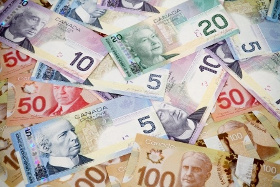The US dollar is extending its weakness to start the trading week, driven mostly by optimism in the broader financial market amid the latest coronavirus vaccine from Oxford-AstraZeneca. This comes soon after Pfizer and Moderna announced their own two-dose inoculations in preventing COVID-19. With economic data being mostly quiet on Monday, traders will be looking for the latest hints regarding US fiscal stimulus and relief packages.
AstraZeneca, the British pharmaceutical juggernaut, announced on Monday that its coronavirus vaccine maintains an average efficacy rate of 70% in protecting against the highly infectious respiratory illness. The vaccine, which was developed in partnership with the University of Oxford, had been assessed over two different dosing regimens, according to an interim analysis of 131 clinical trials and more than 23,000 volunteers.
One dosing program had an effective rate of 90% with a half-dose, followed by a full dose a month later. The other regimen showcased 62% effectiveness when trial participants received two full doses a month apart. This gave the researchers an average vaccine efficacy of 70%.
Oxford-AstraZeneca scientists were quick to point out that there were no hospitalizations or severe cases of the disease when participants were given the treatment.
Professor Andrew Pollard, the chief investigator of the Oxford Vaccine Trial, said in a statement:
These findings show that we have an effective vaccine that will save many lives.
Excitingly, weâve found that one of our dosing regimens may be around 90% effective and if this dosing regime is used, more people could be vaccinated with planned vaccine supply.
Pascal Soriot, CEO of AstraZeneca, called it an “important milestone” in the fight against the global pandemic.
Surprisingly, AstraZeneca shares fell 1.5% in pre-market trading. The leading benchmark indexes recorded modest gains to start the trading week.
The COVID-19 public health crisis has decimated the US and global economies. The US has reported more than 12.3 million cases, adding to the international pile of nearly 59 million confirmed infections. Although companies are manufacturing vaccines, the logistics and distribution challenges could mean that lockdowns, restrictions, and public health mandates could be the norm for all of 2021.
On the data front, the Chicago Federal Reserve Bank’s National Activity Index climbed from 0.32 in September to 0.83 in October, supported by improvements in production, employment, and sales and inventories. IHS Markit will also release its composite, manufacturing, and services flash purchasing managers’ index (PMI) readings later on Monday.
The US Dollar Index, which measures the greenback against a basket of currencies, tumbled 0.36% to 92.06, from an opening of 92.37, at 13:03 GMT on Monday. The index is coming off a weekly loss of 0.65%, adding to its year-to-date decline of 4.5%.
The USD/CAD currency pair fell 0.23% to 1.3064, from an opening of 1.3096. The EUR/USD advanced 0.3% to 1.1892, from an opening of 1.1858.
If you have any questions, comments, or opinions regarding the US Dollar, feel free to post them using the commentary form below.



Be First to Comment